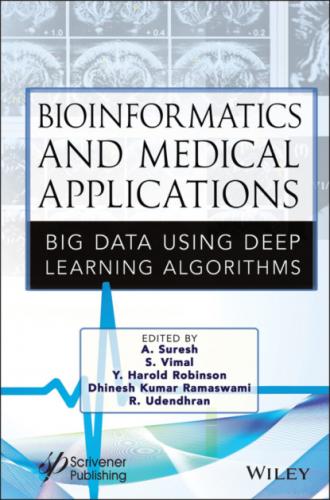299 298
300 299
301 300
302 301
303 302
304 303
305 304
306 305
307 306
308 307
309 308
310 309
311 310
312 311
313 312
314 313
315 315
316 316
317 317
318 318
319 319
320 320
321 321
Bioinformatics and Medical Applications
Big Data Using Deep Learning Algorithms
Edited by
A. Suresh
S. Vimal
Y. Harold Robinson
Dhinesh Kumar Ramaswami
and
R. Udendhran
This edition first published 2022 by John Wiley & Sons, Inc., 111 River Street, Hoboken, NJ 07030, USA and Scrivener Publishing LLC, 100 Cummings Center, Suite 541J, Beverly, MA 01915, USA
© 2022 Scrivener Publishing LLC
For more information about Scrivener publications please visit www.scrivenerpublishing.com.
All rights reserved. No part of this publication may be reproduced, stored in a retrieval system, or transmitted, in any form or by any means, electronic, mechanical, photocopying, recording, or otherwise, except as permitted by law. Advice on how to obtain permission to reuse material from this title is available at http://www.wiley.com/go/permissions.
Wiley Global Headquarters 111 River Street, Hoboken, NJ 07030, USA
For details of our global editorial offices, customer services, and more information about Wiley products visit us at www.wiley.com.
Limit of Liability/Disclaimer of Warranty While the publisher and authors have used their best efforts in preparing this work, they make no representations or warranties with respect to the accuracy or completeness of the contents of this work and specifically disclaim all warranties, including without limitation any implied warranties of merchantability or fitness for a particular purpose. No warranty may be created or extended by sales representatives, written sales materials, or promotional statements for this work. The fact that an organization, website, or product is referred to in this work as a citation and/or potential source of further information does not mean that the publisher and authors endorse the information or services the organization, website, or product may provide or recommendations it may make. This work is sold with the understanding that the publisher is not engaged in rendering professional services. The advice and strategies contained herein may not be suitable for your situation. You should consult with a specialist where appropriate. Neither the publisher nor authors shall be liable for any loss of profit or any other commercial damages, including but not limited to special, incidental, consequential, or other damages. Further, readers should be aware that websites listed in this work may have changed or disappeared between when this work was written and when it is read.
Library of Congress Cataloging-in-Publication Data
ISBN 978-1-119-79183-6
Cover image: Pixabay.Com Cover design by Russell Richardson
Set in size of 11pt and Minion Pro by Manila Typesetting Company, Makati, Philippines
Printed in the USA
10 9 8 7 6 5 4 3 2 1
Preface
This book features bioinformatics applications in the medical field that employ deep learning algorithms to analyze massive biological datasets using computational approaches and the latest cutting-edge technologies to capture and interpret biological data. In addition to delivering the various bioinformatics computational methods used to identify diseases at an early stage, it also collects cutting-edge resources in a single source designed to enlighten the reader with topics centered on computer science, mathematics, and biology. Since bioinformatics is critical for data management in the current fields of biology and medicine, this book explains the important tools used by bioinformaticians and examines how they are used to evaluate biological data in order to advance disease knowledge.
As shown in the chapter-by-chapter synopsis that follows, the editors of this book have curated a distinguished group of perceptive and concise chapters that reflect the current state of medical treatments and systems and offer emerging solutions for a more personalized approach to the healthcare field. Since applying deep learning techniques for data-driven solutions in health information allows automated analysis, this method can be more advantageous in addressing the problems arising from medical- and health-related information.
– Chapter 1, “Probabilistic Optimization of Machine Learning Algorithms for Heart Disease Prediction,” discusses the ensemble learning that overcomes the limitations of a single algorithm, such as bias and variance, by using a multitude of algorithms. It highlights the importance of ensemble techniques in improving the forecast accuracy and displaying an acceptable performance in disease prediction. Additionally, the authors have worked on a procedure to further improve the accuracy of the ensemble method post application by focusing on the wrongly classified records and using probabilistic optimization to select pertinent columns by increasing their weight and doing a reclassification which would result in further improved accuracy.
– Chapter 2, “Cancerous Cells Detection in Lung Organs of the Human Body: IoT-Based Healthcare 4.0 Approach,” analyzes three types of cancer—squamous cell carcinoma, adenocarcinoma, and large cell carcinoma—derived from lung tissue, and investigates how AI can customize treatment choices for lung cancer patients.
– Chapter 3, “Computational Predictors of the Predominant Protein Function: SARS-CoV-2 Case,” describes the main molecular features of SARS-CoV-2 that cause COVID-19 disease, as well as a high-efficiency computational prediction called the polarity index method. Furthermore, it presents a molecular classification of the RNA-virus and DNA-virus families with results obtained by the proposed non-supervised method focusing on the linear
